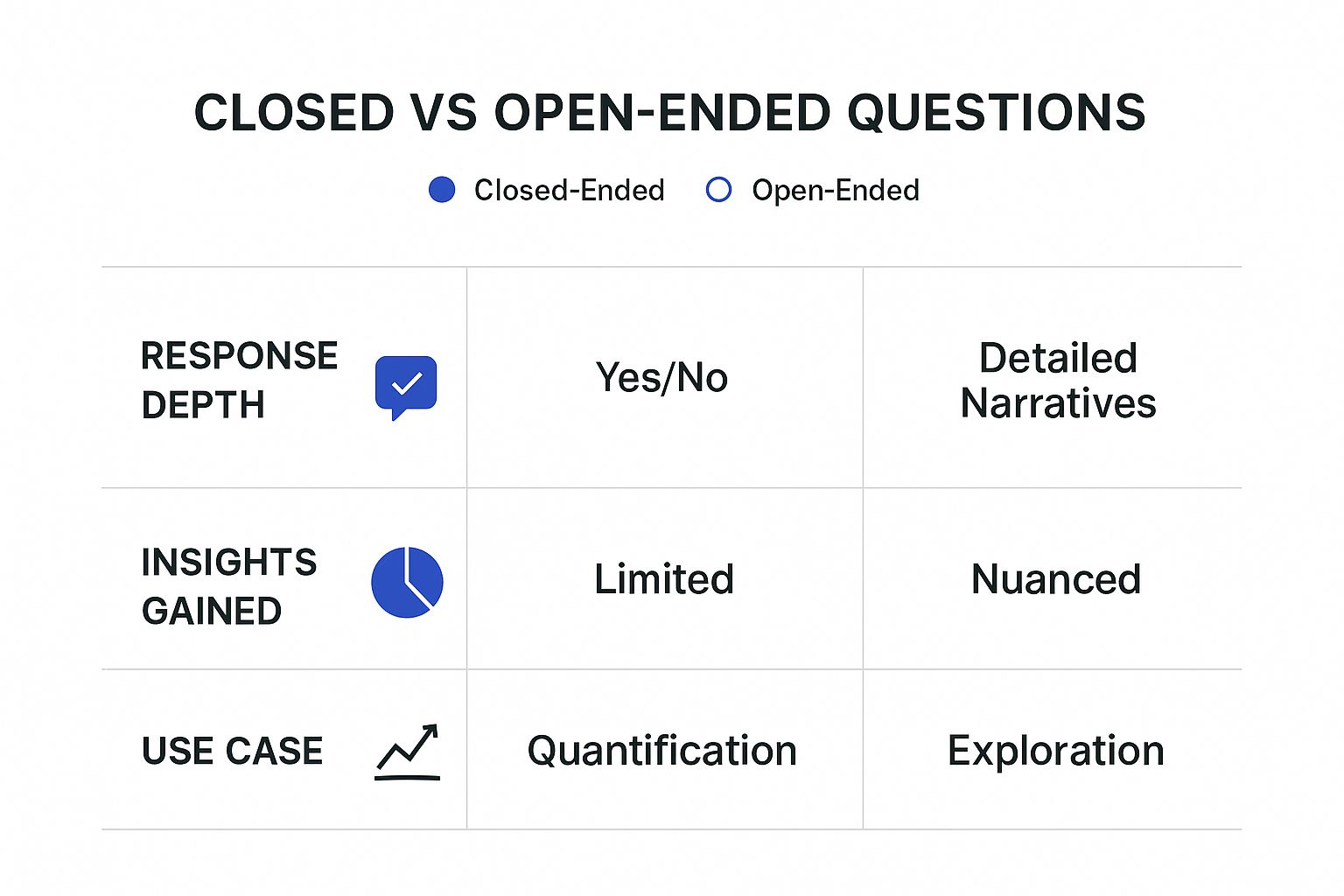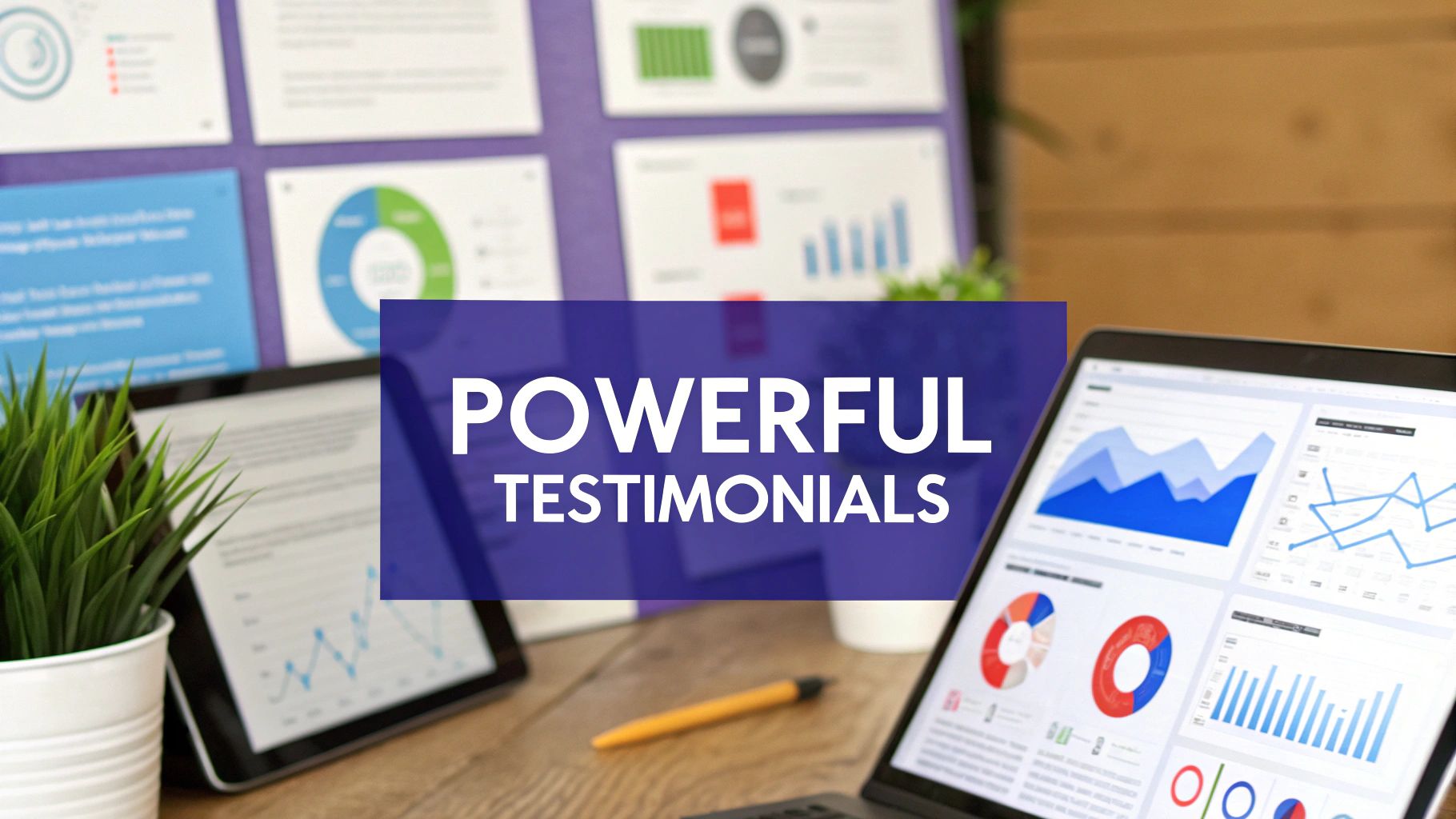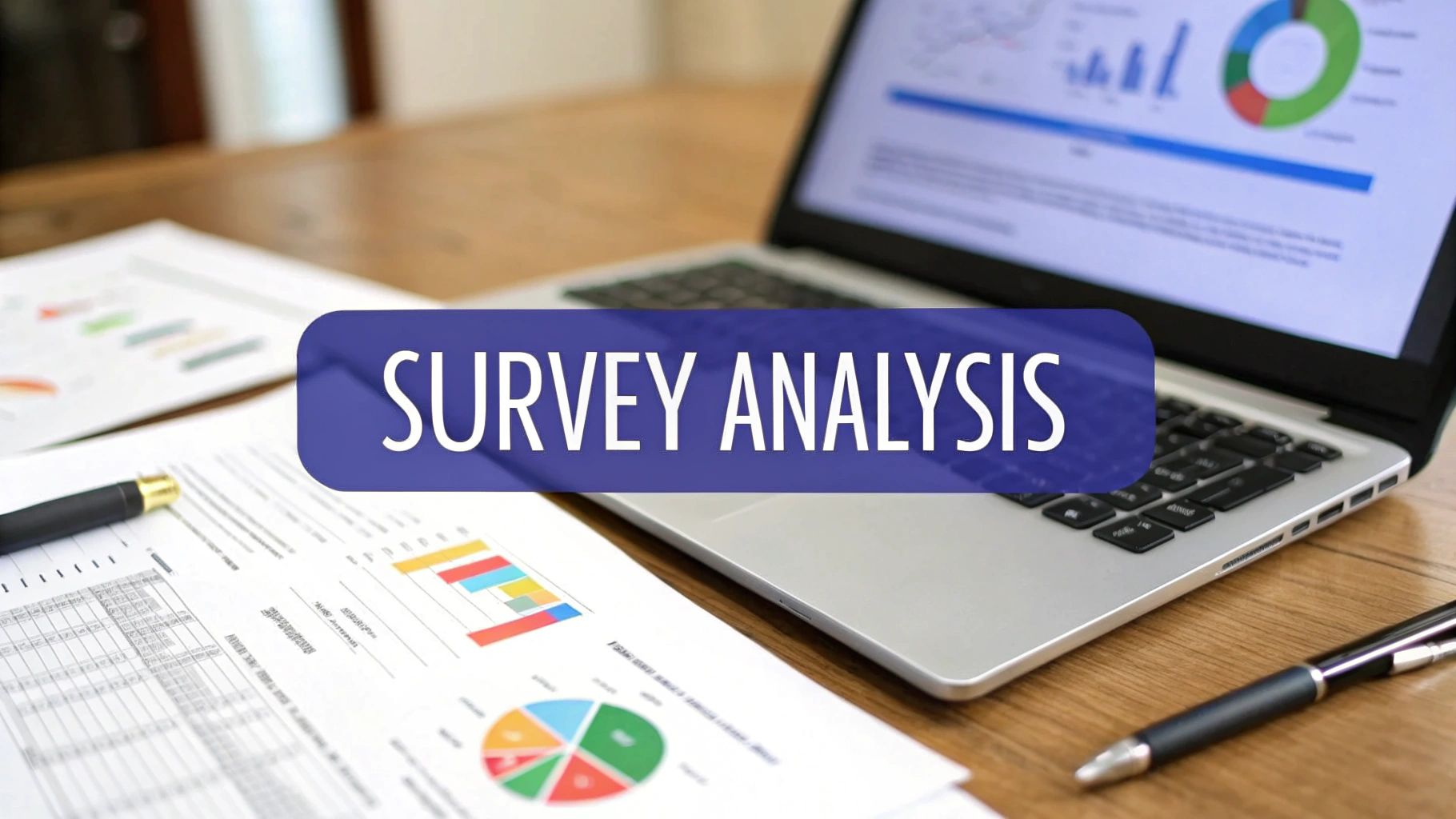Mastering Open Ended Research Questions for Better Insights
Learn how to craft effective open ended research questions. Discover tips and examples to uncover what your users truly think. Read more today!

Think about the difference between asking, "Did you like our new feature?" versus "What was your experience like using our new feature?"
The first question is a dead end. You'll get a simple "yes" or "no." The second one, though? That’s the start of a real conversation. This is the core idea behind open-ended research questions. They are designed to invite detailed, personal stories instead of forcing people into a simple, predefined box.
Unlocking Deeper User Insights

Simply put, open-ended questions are prompts that can't be answered with a single word. They encourage people to respond in their own words, which is where you find authentic feedback. Instead of boxing users into a neat set of answers you've already thought of, you’re handing them a blank canvas to share what's truly on their mind.
This is how you get to the "why" behind what your users do. You uncover their thoughts, feelings, and motivations straight from the source. For any SaaS company, this kind of feedback is valuable. It directly shapes product development, sharpens your marketing message, and can even steer your business strategy.
The Power of "Why" and "How"
A simple yes/no question just confirms what you already suspect. But an open-ended question that often starts with "Why," "How," or "What" uncovers the things you never would have thought to ask in the first place.
Here’s why this approach is so powerful:
- Richer Data: You move beyond numbers and collect detailed, qualitative feedback that gives you the full story.
- Unexpected Discoveries: Your users will bring up issues, ideas, or frustrations you had not considered.
- Authentic Voice: You hear feedback in your customer's own language, which is perfect for nailing your marketing copy and support docs.
- Better User Connection: It shows you value their opinion, not just a quick checkbox answer.
By asking questions that prompt a story rather than a statistic, you get a much clearer picture of the user experience. You move from collecting data to gathering genuine stories and perspectives about your product.
This guide will show you exactly how to craft and use open-ended research questions to get the kind of feedback that drives real growth. We’ll cover everything from writing effective questions to analyzing the responses without getting overwhelmed. The goal is to give you a practical framework for building a better product based on what your users actually think and feel.
Why Nuanced Feedback Is So Valuable
Multiple-choice questions are great for measuring things you already know about. But they can't possibly capture the whole story. They put guardrails on feedback, guiding users toward a pre-approved set of answers. This is exactly where open-ended research questions change the game, letting you gather the kind of nuanced data that reveals the true picture of human opinions.
When you ask an open-ended question, your respondents can finally share the context behind their answers. They can explain why they feel a certain way, express uncertainty, or bring up a frustration you never would have thought to ask about. This kind of feedback is far more authentic and detailed, giving you a much richer look into what your customers are actually thinking.
The infographic below shows the core differences between these two approaches.

As you can see, the choice between them really comes down to your goal. If you need to quantify what you already know, closed-ended questions are your tool. But if you want to explore the unknown, you need to go open-ended.
Beyond Simple Metrics
While closed-ended questions are solid for tracking high-level metrics and putting numbers to things, they fall short when you need to explore new ideas, motivations, and pain points. That’s where open-ended questions come in. They provide the qualitative depth you need to get a handle on your users' perspectives and experiences. This is how you discover the "why" behind the "what."
For instance, a closed question might tell you 70% of users are satisfied. That’s a good start. But an open-ended question tells you why the other 30% are not, in their own words.
Open-ended questions turn a monologue into a dialogue. Instead of confirming your assumptions with data, you invite your customers to tell you what's really on their minds, uncovering insights you might have otherwise missed.
This kind of deep listening is important for any SaaS business looking to innovate and stay ahead of customer needs.
Uncovering Authentic Opinions
Research shows that open-ended survey questions pull in richer and more nuanced data, especially when you’re digging into complex or mixed opinions. Closed questions can sometimes nudge people toward what they think is a socially acceptable answer. Open-ended questions give them the freedom to elaborate, explain conditional views, and provide the detailed reasoning behind their thoughts.
The value of this kind of feedback is often amplified when you pair it with strategies for optimizing your email response rate. After all, getting more responses means you have a more accurate and representative set of insights to work with.
Open-ended questions move you from collecting data to achieving genuine insight. They help you build products and create experiences based on what people actually need and want, not just what a multiple-choice option allowed them to say. That shift in feedback quality can have a massive impact on your product development, customer retention, and overall growth.
How to Write Effective Open Ended Questions

There’s an art to crafting open-ended questions that actually get you the rich, insightful answers you're looking for. It’s a skill. The whole point is to create prompts that encourage people to think and elaborate, all without accidentally leading them down a path you’ve already paved.
It all starts with using neutral and unbiased language.
Good questions give people the space to share what’s truly on their minds. The moment your question hints at a "correct" response, you're no longer collecting honest feedback. You're just collecting data that confirms your own biases. To get this right, check out our guide on avoiding biased survey questions.
The best questions are also very focused. If you try to cover too much ground in a single prompt, you’ll just confuse people and end up with vague, useless answers. Stick to one specific topic per question.
Start with the Right Words
The first few words of your question can make or break it. Certain words just naturally invite more thoughtful, detailed responses.
- How: This one is perfect for asking about a process or a feeling. Think, "How did you feel about the new onboarding process?"
- Why: Use this to dig into the motivation behind an action. A classic example is, "Why did you choose to downgrade your plan?"
- What: This word is great for gathering specific opinions or identifying problems. For instance, "What challenges did you face when setting up your account?"
- Tell me about...: This is a fantastic conversational prompt that encourages storytelling. Try, "Tell me about a time you found our support team helpful."
These starters are like opening a door for your users. They signal that you’re interested in their story, not just a one-word answer.
Common Pitfalls to Sidestep
Knowing what not to do is just as important as knowing what to do. A few common mistakes can easily derail your efforts to collect quality feedback, so keep an eye out for these when you’re writing your survey.
The biggest offender is asking leading questions. These are sneaky questions that bake in an assumption or steer the person toward a specific answer. Asking something like, "How much did you enjoy our amazing new feature?" assumes they found it amazing from the get-go.
Another trap is asking questions that are way too broad. A question like "What do you think of our product?" is so massive that most people won't even know where to begin. This usually results in generic feedback or, worse, a skipped question. To learn how to structure questions that are both open and focused, methodologies like the SPIN selling framework offer some really useful models.
Key Takeaway: The best open-ended research questions are specific enough to guide the respondent to a topic but open enough to let them answer freely and honestly in their own words.
Crafting Better Open Ended Questions
Sometimes, seeing a side-by-side comparison makes all the difference. The table below shows how a few simple tweaks can transform a weak question into one that’s guaranteed to generate far more valuable insights.
As you can see, the improved versions don't tell the user what to think. They simply open the floor and invite an honest, detailed response which is exactly what you need.
Open Ended Question Examples for SaaS Surveys

Theory is one thing, but seeing open-ended questions in the wild is the best way to really get a feel for their power. For any SaaS company, these questions are your direct line into the real user experience. They help you find friction points, get gut checks on new ideas, and discover growth opportunities you never knew existed.
The trick is to match your questions to a specific goal. Are you trying to smooth out your onboarding flow? Figure out why users are churning? Get some honest feedback on a new feature? Each of those goals needs its own set of questions.
Let’s dig into some practical examples you can borrow and tweak for your own surveys, broken down by common SaaS goals.
Questions for Onboarding Feedback
Those first few moments a user spends with your product are absolutely critical. Open-ended questions can uncover frustrating sticking points that your analytics dashboards will never show you. The goal here is to learn about their initial journey and pinpoint any confusion right away.
- What was the very first thing you tried to do after signing up?
- Can you describe any moments where you felt stuck or weren't sure what to do next?
- What were you hoping to get done in your first session, and did you manage to do it?
These prompts nudge users to tell you a story about their experience, giving you a play-by-play of their first impression. That's so much more valuable than just asking if onboarding was "easy" or "hard."
Questions for New Feature Feedback
When you roll out a new feature, you need more than just usage numbers. You need to know if it’s actually solving the right problem and if it feels intuitive to use. These kinds of open-ended questions help you get that specific, actionable feedback.
Asking users to walk you through their experience is a powerful technique. It prompts them to recall specific actions and feelings, providing a detailed account of how they actually use your product, not just how they think they use it.
- Walk me through what it was like using our new reporting dashboard for the first time.
- How might this new feature change how you currently get your work done?
- What’s one thing you expected this feature to do that it didn’t?
Questions to Understand Customer Churn
Figuring out why customers leave is probably one of the most important jobs for open-ended questions. A multiple-choice "reason for leaving" is often too simplistic. To spot real patterns and fix the underlying problems, you need the full story. For more ideas on this, check out a great example of an open-ended question in one of our other articles.
Here are a few questions you should build right into your cancellation flow:
- What was the main reason you decided to cancel your subscription today?
- What problem were you ultimately trying to solve when you first signed up for our tool?
- Was there anything we could have done differently to have kept you as a customer?
These questions give departing customers one last chance to be heard. Their answers often contain the most brutally honest feedback you’ll ever get, making it an incredibly valuable resource for boosting your retention.
But Open-Ended Questions Aren't Always Easy Street
While open-ended questions are fantastic for digging up rich, detailed feedback, they do come with their own set of speed bumps. It’s important to go in with your eyes open and know the potential hurdles you might face.
The biggest one? A higher rate of people just skipping the question.
Think about it. It takes more brainpower to type out a thoughtful answer than it does to just click a radio button. That extra effort can be enough to make someone bail on the question, especially if they’re short on time or just not that invested in your survey.
Why You Get Such a Mixed Bag of Responses
Beyond people skipping the question, the quality and length of the answers you do get can be all over the place. A few things can influence how a person responds, and knowing what they are will help you make sense of your data.
- Device Type: Someone sitting at a desktop with a full keyboard is probably going to give you a detailed, multi-sentence reply. The person tapping out an answer on their phone during their commute? Expect something much shorter.
- Respondent Demographics: Age and how comfortable someone is with tech can also play a part. Certain groups might be more inclined to write out detailed feedback than others.
- Survey Fatigue: If your survey is a marathon, respondents might be totally drained by the time they get to your open-ended questions. That means you’re more likely to get short, low-effort answers.
These inconsistencies don't mean the data is useless. They just add a layer of context that helps you analyze the feedback more effectively. Spotting these patterns is key to drawing the right conclusions from your qualitative data.
Knowing the potential for nonresponse or varied answer quality is a reason to design your research thoughtfully, get ahead of these issues, and collect more reliable insights.
This isn't just a hunch; the data backs it up.
A 2023 study from the Pew Research Center that surveyed over 10,000 U.S. adults confirmed this trend. They found that while open-ended questions deliver richer qualitative data, they also have much higher nonresponse rates that differ across various groups.
The research showed that younger folks and people on mobile devices were more likely to skip questions or give shorter answers compared to older respondents or those on desktops. You can dig into the complete findings on nonresponse rates on Pew Research Center.
By knowing these challenges exist, you can design your surveys to minimize them and still get the high-quality, nuanced feedback you’re after.
Analyzing Qualitative Data Without the Headache
Okay, so you’ve collected hundreds, maybe even thousands, of thoughtful, text-based answers. Now what? The biggest hurdle for most teams is figuring out what to do with all that qualitative feedback. The thought of manually sifting through it all can feel overwhelming.
But here’s the good news: you don’t have to. Modern tools have made this process much more manageable.
You no longer need to rely on a team huddled in a room with spreadsheets and sticky notes. Today, software powered by Natural Language Processing (NLP) can make sense of huge volumes of responses in a fraction of the time. These tools automatically analyze the text, group similar feedback into common themes, and show you what matters most to your users.
This technology is what makes large-scale qualitative research practical. It means you can confidently use open-ended research questions in your surveys without burying your team in an impossible mountain of data.
Making Sense of the Data
So, how do these tools actually work their magic? One of the most common techniques is called topic modeling.
Think of it like an automated sorting system for your feedback. The software reads through every single response, identifies patterns, and picks up on recurring words. It then groups similar comments into clusters, or "topics." For example, it might create a topic for all the feedback related to "pricing," another for the "user interface," and a third for "customer support."
This instantly gives you a bird's-eye view of the most common themes bubbling up in your feedback.
Instead of reading every single response just to find the trends, topic modeling shows you the trends first. This lets you focus your attention on the most talked-about subjects, saving you an incredible amount of time.
Advanced NLP techniques have truly changed the game for analyzing open-ended survey responses. Methods like Biterm Topic Modeling (BTM) help researchers efficiently pull out themes from large sets of short text answers, like the kind you might get from a national survey. In fact, you can see how organizations like Gallup use NLP for open-ended questions to get a deeper look at this in action.
From Themes to Actionable Insights
Once you have these high-level themes, the next step is to dig in. Most tools will let you click into each topic to see the actual responses, so you can read the specific comments people left about pricing or your customer support.
This combination of automated analysis and human review is very powerful. You get the speed and scale of a machine paired with the nuanced perspective of a person.
This approach is the core of effective survey data analysis. It’s all about turning that raw, messy feedback into clear, actionable steps you can take to make your product better. Your team can move from data collection to decision-making much, much faster.
Got Questions? We've Got Answers
When you start weaving open-ended questions into your surveys, a few common questions always seem to pop up. Let's tackle them head-on.
How Many Open-Ended Questions Are Too Many?
There isn’t a magic number, but the golden rule is to be intentional. Piling on too many open-ended questions is a surefire way to trigger survey fatigue, which means people will bail before they even finish. In fact, a study from SurveyMonkey found that response quality starts to tank after the 7-8 minute mark.
For most surveys, a sweet spot is 2-3 well-chosen open-ended questions. Place them where you need the richest context, maybe right after a critical multiple-choice question or at the very end to scoop up any final thoughts.
How Can I Get People to Actually Answer Them?
Getting thoughtful, detailed responses usually comes down to how you ask. It's less about the question itself and more about the invitation.
- Be specific, not lazy. Avoid the vague, "Any feedback?" Instead, try something like, "What's one thing we could improve on our dashboard to make your daily work easier?" Specificity guides their thinking.
- Make it optional. This might sound counterintuitive, but forcing an answer often leads to low-effort replies. Making the question optional respects their time and, funny enough, often encourages higher-quality answers from people who genuinely want to share.
- Show them the 'why'. People are more willing to help if they know how their feedback makes a difference. A simple line like, "Your answer will help our product team figure out what to build next," can be very motivating.
What's the Best Way to Ask a 'Why' Question?
Asking "Why?" can sometimes feel a bit like an interrogation. It can put people on the defensive, making them less likely to give you an open, honest answer. Instead of a blunt "Why did you cancel?" which sounds a little accusatory, you can soften the approach.
A much better way to phrase it is, "What was the main reason you decided our tool wasn't the right fit for you at this time?" This simple tweak shifts the focus from their action to the product's fit, which feels a lot less personal and invites a more constructive response.
That small change in wording removes any hint of blame and encourages a far more thoughtful answer.
Ready to turn user feedback into your biggest growth lever? Surva.ai gives you the tools to ask the right questions and automatically makes sense of the answers. Stop guessing, reduce churn, and build a product people can't live without. Learn more and get started at https://www.surva.ai.


